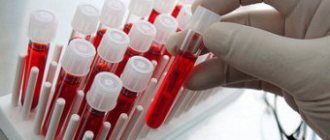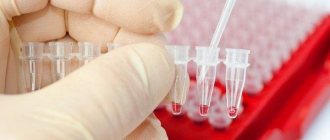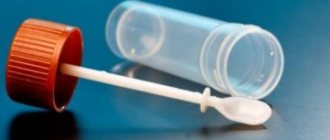Pregnancy is an excellent state for a woman, because a new life has been born in her, and another baby will soon be born. In addition to joy, the expectant mother also has additional worries:
- you need to monitor your nutrition, take care of its completeness;
- lead a healthy lifestyle;
- adjust work and rest schedules;
- to refuse from bad habits;
- Pay attention to your health and be under constant medical supervision.
This way you can carry and give birth to a healthy baby. The gynecologist, in turn, in addition to weighing, examining, checking general well-being, blood pressure and heart indicators, prescribes a whole series of clinical tests, including a smear.
Normal indicators
A vaginal smear is one of the mandatory tests when registering a pregnant woman.
Such a study helps to quickly and effectively detect abnormalities in the patient’s genitourinary area. A smear shows whether a woman’s leukocyte level is normal or whether their number is increased, which indicates the development of a certain pathology. During pregnancy, leukocytes in a smear are checked several times: when registering for pregnancy and at 30 weeks. These studies are carried out if the first analysis revealed a normal leukocyte count. If already at the first diagnosis the results showed increased results, then a thorough diagnosis is carried out, the causes of the increase are eliminated, and then during gestation several control smear tests are carried out on the flora to eliminate the possibility of re-development of infectious pathology.
Leukocytes are present in certain quantities in the body of each patient, so experts have established a kind of norm of leukocytes in a smear during pregnancy, which is 10-20 units in the field of view being examined. In other words, normally the number of leukocyte cell structures should not exceed 20 units in the area that a specialist sees through the microscope eyepiece when studying a smear.
It is the area that is simultaneously viewed in the microscope that is called the field of view. If the content of leukocyte cells exceeds the norm, then the doctor has every reason to suspect the presence of an infectious-inflammatory process. To determine the specific nature of the disease, a woman undergoes a whole series of diagnostic procedures, which allows her to accurately determine the true reasons for the increase in leukocyte counts.
What do white cells in urine indicate?
The growth of white blood cells in a general urine test does not yet indicate the occurrence of a disease in the body. It is also worth considering that poor hygiene of a pregnant woman before taking tests, as well as a poorly washed jar, can cause such results. Therefore, before taking the test, you should be more vigilant to avoid foreign substances getting into it. First of all, rinse the jar and sterilize it, or buy a special container for this purpose at the pharmacy.
What do white cells in urine indicate?
In addition, an increased growth of white blood cells in the mother's body may indicate possible inflammatory diseases in the genitourinary organs. Often during pregnancy, many people complain of cystitis.
The presence of a large number of white blood cells may indicate kidney disease. The most dangerous among them is pyelonephritis.
Common candidiasis and other sexually transmitted infections can cause the growth of a large number of white blood cells.
Under any circumstances, if leukocytes are elevated in the blood or urine during pregnancy, you will have to undergo more than one examination. The examination results will help you find the root cause of their growth in order to choose the right treatment.
Leukocytosis during pregnancy
Leukocytes play an irreplaceable role in the human body. Thanks to them, many important protective functions are carried out and immunity is developed. Therefore, our health directly depends on the number of leukocytes in the blood.
If it exceeds the norm, undesirable processes begin and develop, sometimes leading not only to serious illnesses, but also to death.
This material explores this topic that is relevant to any of us, considering the reasons why leukocytes in the blood are elevated during pregnancy, as well as the therapeutic and other measures that should be taken to normalize this situation.
Treatment method for leukocytosis in pregnant women.
What are leukocytes
Leukocytes are white blood cells that play in the body, as already noted, a complex of protective functions on which the state of health directly or indirectly depends.
- The fact that leukocytes in the blood are elevated during pregnancy most often indicates natural processes associated with the growth of the child in the womb.
- Mostly leukocytosis (increased levels of white blood cells) in pregnant women is a physiological phenomenon that is not considered a pathology if it falls within the established framework.
- However, significant deviations from the norm indicate that it is necessary to begin treatment.
Human blood is a substance that has a complex composition. The fluid circulating through the vessels contains many cells that perform special functions.
The medium for the life of these cells is plasma - a transparent substance that makes up approximately half the volume of all blood. It helps the movement of red and white blood cells throughout the body.
White blood cells are leukocytes. The general designation of leukocytes is written with the Latin abbreviation WBC, which in English stands for white blood cell (“white blood cells”).
Leukocytosis during pregnancy is a condition of the body in which the concentration of white blood cells (leukocytes) in the bloodstream increases. Every pregnant woman regularly undergoes a blood test, which shows not only the hemoglobin level, but also the number of leukocytes - it is important that the leukocytes in the blood are not increased or decreased, as this is evidence of pathology.
Normally, the level of white blood cells can fluctuate from 4 to 8.8x109/l, but in pregnant women it is considered normal to increase leukocytes in the blood to 11x109/l. A slight increase in the number of white blood cells during pregnancy indicates activation of the immune system, an increase in the erythrocyte sedimentation rate and slight thickening of the blood.
In cases where leukocytes in the blood increase significantly, leukocytosis develops, which indicates the presence of inflammatory processes or other pathologies in pregnant women that require immediate treatment.
Causes of leukocytosis
Leukocytosis can develop in pregnant women for various reasons. The most common reasons for this violation are:
- ARVI, acute respiratory infections and other inflammatory diseases that a woman could become infected with during pregnancy;
- severe pathologies, such as viral pneumonia or chickenpox, dangerous not for the woman herself, but for the child in her womb;
- an allergic reaction to certain medications prescribed by a doctor;
- receiving injuries, burns and other traumatic injuries (scratches with suppuration, abscesses, fractures and others).
Also, the reasons that a woman has developed leukocytosis may be associated with severe processes in her body, for example, with the disintegration of malignant tumors or internal bleeding.
In some cases, pregnant women develop leukocytosis against the background of increased psycho-emotional stress.
Therefore, doctors recommend that pregnant women avoid stress, as well as physical and mental fatigue.
Classification of leukocytosis
Sometimes leukocytosis is physiological and not pathological, that is, it occurs as a reaction to the action of certain environmental factors. For example, white blood cells in pregnant women may increase if they take a bath that is too hot or too cold.
Also, the number of leukocytes in the blood may increase due to errors in the diet of a pregnant woman, which requires the doctor to correct her diet.
Engaging in heavy physical work can also provoke leukocytosis, but it is important to remember that such leukocytosis is shown by tests only if they are carried out in the near future after an external influence on a woman of an unfavorable factor.
If leukocytosis is detected in the blood of a pregnant woman after a long time after such exposure, we are already talking about a pathological condition.
The most serious reasons that can cause an increase in the level of leukocytes in the blood of pregnant women are:
- abscesses;
- peritonitis;
- sepsis.
These conditions are dangerous not only for the child, but also for the life of the mother, so if diagnosis is not carried out in a timely manner and treatment is not prescribed, the child in the womb of a pregnant woman and she herself may die.
These diseases are dangerous in themselves, but their danger also lies in the fact that they can provoke the development of deformities in the fetus, as well as cause premature birth.
Also, a low level of leukocytes in the blood can be observed when a woman is exposed to radiation, when her body is exposed to certain harmful chemicals, or when exhausted.
The number of leukocytes in the blood of pregnant women can be determined using a routine blood test. Treatment begins with establishing the cause of leukocytosis. To do this, sometimes it is necessary to conduct a complete examination of the woman. Once the diagnosis is established, the gynecologist who is caring for the woman’s pregnancy makes a decision regarding further treatment.
The drugs used must be harmless to both mother and child. But unfortunately, not in all cases it is possible to eliminate leukocytosis and the pathology that caused it without harming the health of the pregnant woman and the baby in her womb. Therefore, sometimes, in severe pathological conditions, the doctor may decide to terminate the pregnancy and save the life of the woman herself.
Elevated leukocytes in a smear during pregnancy are an indication for additional examination. To exclude the possibility of medical error, incorrect counting of leukocytes, the analysis is repeated. Once the result is confirmed, a course of therapy is prescribed. Doctors select treatment individually, based on the results obtained, the stage of the disease, the severity of its symptoms, and the presence or absence of additional diseases.
A large number of leukocytes in a smear during pregnancy requires medical intervention. When drawing up an algorithm for therapeutic effects, the gestational age, the state of health of the pregnant woman, and the sensitivity of the detected microorganisms to antibiotics are taken into account. The drugs used are selected taking into account the reason that caused the increase in leukocytes. So, for candidiasis, antifungal drugs are used:
- Nystatin;
- Pimafucin;
- Sertaconazole.
In cases where the cause of an increase in leukocyte structures is gonorrhea or another sexually transmitted infection, antibacterial drugs are prescribed. Among those allowed during pregnancy:
- Cefixime;
- Ceftriaxone;
- Azithromycin.
When a lot of leukocytes are recorded in a smear during pregnancy, traditional therapy can come to the aid of a woman. However, any use of medicinal herbs must be agreed with a doctor. Among the effective recipes:
- Chamomile. Brew 2 tablespoons of flowers in 500 ml of water, bring to a boil, and cool. Douching is carried out 2 times a day, until the vaginal suppositories prescribed by the doctor are placed.
- Aloe juice and honey. The ingredients are taken in equal parts, applied to a cotton-gauze swab, and inserted into the vagina before bed. Course 15 days.
- Sitz baths with chamomile, nettle, oak bark, St. John's wort. Herbs are taken in equal proportions and a mixture is prepared. 4 tablespoons are poured with water at 45-50 degrees and baths are made.
It often happens that the leukocyte count during pregnancy increases slightly, which is usually the result of some kind of infectious disease. Moreover, the very fact of infection could have happened even before conception; it’s just that during pregnancy, the mother’s immune system is seriously weakened, which leads to an exacerbation of the condition.
A decrease in immune status is necessary for the fetus to successfully attach and take root in the uterine cavity, otherwise the immune system will provoke its rejection, but at the same time there is a dangerous weakening of the body’s defense systems, which makes it vulnerable. Most often, leukocytes in a smear during pregnancy are detected at elevated levels under the influence of the following factors:
- Pathological conditions such as mycoplasmosis and ureaplasmosis, genital herpes or gonorrhea, syphilitic lesions and other sexually transmitted diseases.
- Often, leukocytosis is a consequence of inflammatory lesions or candidiasis, which is often called thrush. Moreover, in pregnant women, against the background of a decrease in immune status, thrush is detected quite often.
- Another fairly common reason why elevated white blood cells are found in a smear during pregnancy is vaginosis, which also occurs due to infection, but is not of an inflammatory nature. Bacterial vaginosis occurs against the background of an unhealthy diet, weak intestines, incorrectly selected panties, weak immunity, etc. It can develop for a long time and proceed hidden, and only appear during pregnancy, when the body is weakened. This disease is typically characterized by the presence of a fishy odor from the vaginal cavity, grayish-white discharge, and uncomfortable, itchy or burning sensations in the genitals. The pathology is dangerous for pregnant women because it can provoke spontaneous abortion, premature delivery, postpartum endometritis and other dangerous conditions.
- Urethritis, endometritis or adnexitis are also accompanied by an increase in leukocyte levels in the vaginal smear.
- A frequent provocateur of an increase in leukocytes is intestinal dysbiosis, which is generally safe for pregnancy, but can cause frequent constipation, especially in the 2-3 trimester. And constipation in this condition often leads to the development of hemorrhoids.
How many days does a smear cytology test take?
A pregnant woman should take a smear test for flora after carefully preparing, because it is very important to promptly detect inflammation or pathology developing in the body of the expectant mother.
To reduce the likelihood of microorganisms not included in the vaginal flora getting into the analysis, a pregnant woman should abstain from sexual activity during the period of preparation for the test, about two days, and a few hours before visiting the gynecologist, carry out basic hygiene procedures.
In addition, during the preparation period you should avoid using vaginal suppositories and ointments.
Before taking a smear for leukocytes, it is advisable for a pregnant woman not to visit the toilet for two hours, but it is also not recommended to sit on a gynecological chair with a full bladder.
The test should be rescheduled if the pregnant woman had to take any medications within two weeks.
If the expectant mother’s body is not bothered by any symptoms, then she can be tested for leukocytes in a smear only twice: before 12 weeks and after 30 weeks of pregnancy.
With the onset of pregnancy, leukocytes increase not only in the woman’s vaginal environment, but in the urine and blood.
To obtain a more accurate analysis result, it is better to start collecting biological fluid in the middle of urination - for a laboratory examination, 1 - 2 ml of liquid material will be enough.
To donate blood for leukocytes, a pregnant woman does not require any special preparation of the body, except that she should go for the procedure on an empty stomach.
MORE: Website of biology teachers of MBOU Lyceum No. 2 of Voronezh
But since this can be a difficult ordeal for women carrying a child, they can eat an apple or drink weak sweet tea.
Otherwise, at least four hours must pass from the last meal to the blood drawing procedure.
Donating blood from a vein allows you to get an informative result - such biomaterial is of higher quality.
Cytological analysis of a smear usually takes from 1 to 5 days.
It is important to remember that the oncological process does not occur in a few days. Quite a long time passes from the first pathological changes to malignant degeneration.
Therefore, timely detection of atypical cells in a woman’s body makes it possible to prevent the development of cervical cancer. For these purposes, an accessible and simple method for the early diagnosis of malignant cells was introduced everywhere - a cytological examination of a smear.
Revealing
If leukocytes in a smear of pregnant women are found in a rather elevated concentration, then it is imperative to determine the reasons for such an increase. For this purpose, the pregnant woman is prescribed an additional examination, because it is impossible to determine the true causes of the problem only by the results of a smear. Additional diagnostics include studies such as:
- Bacterial culture tests, which help identify pathogenic microorganisms that cause inflammatory processes and reactions;
- Pregnant women are also prescribed PCR diagnostics. Polymerase chain reactions are a fairly accurate diagnostic technique that can detect a lot of infections. The biomaterial taken during the smear is processed in a special device. If an infection occurs, then the samples will necessarily contain the genetic material of those microorganisms that are its causative agents.
- Additionally, immunological diagnostics are carried out, which allows for a detailed examination of the biomaterial and to find out the true factors for increasing the leukocyte level in the gynecological smear.
It is a very erroneous opinion that if there are no pathological signs with an elevated leukocyte level, then nothing needs to be treated. It is very necessary, and as early as possible. Indeed, in the absence of timely therapeutic intervention, there is a high risk of developing a host of complications for the mother herself and the baby she is carrying.
What is a cytology smear?
A smear cytology (Pap test, Papanicolaou test) is a microscopic examination of a smear from the cervix for the purpose of early detection of cancer.
This analysis is also called a hytological smear or oncocytology smear. This examination is easily tolerated by patients because it is completely painless and does not take much time.
A cytological smear not only makes it possible to timely diagnose cellular abnormalities, but also helps to identify the presence of unwanted microflora in the vaginal environment.
At the same time, the test does not provide accurate data on the detected pathologies, and if an unfavorable result is obtained, the patient is sent for additional examination (smear for flora in women) and for testing for STDs.
Using the cytological method, which has been successfully used in gynecological practice for decades, it is possible to identify 5 types of changes in the cells of patients.
Moreover, the research is very simple and affordable. Doctors advise all women aged 18 to 65 to undergo it at least once a year.
Features of the therapeutic approach
When choosing an approach to treatment, the doctor must take into account such nuances as the duration of pregnancy, the age of the patient, and other factors. It is imperative to determine the sensitivity of pathogenic microorganisms to medications. If the reasons for the high leukocyte count are due to thrush, then vaginal suppositories like Nystatin, Pimafucin or Zalain are prescribed, which are safe for the baby.
If leukocytes are activated against the background of gonorrhea or ureaplasmosis, then the decision on treatment is made individually. When there is a risk of infection of the fetus or the development of complications in the mother, antibiotic drugs such as Erythromycin, Azithromycin or Ceftriaxone are prescribed. Similar drugs are also used for syphilis in pregnant women, which is treated in several stages. First, the woman undergoes specific therapy, and then, after 20-24 weeks, preventive therapy is used.
If white blood cells increase due to genital herpes, then the use of any medications is not recommended. They are used only in cases where the risk to the mother is many times greater than the risk to the baby. Most often in such cases, Zovirax ointment is used, which is applied to the external genitalia for a 7 or 10-day course.
Deviations from the norm
Absence of squamous epithelium
indicates a decrease in estrogen saturation of the body, and an increase in its content is observed with severe inflammation.
Information Increase in white blood cell
always indicates an inflammatory process.
Gonococci, Trichomonas, yeast-like fungi
(at a concentration of more than 10 4 CFU/ml) and
key cells
are observed in the corresponding disease.
Copious mucus
also indicates inflammation.
For any deviations from normal values, additional studies are carried out. A bacteriological examination of vaginal discharge is carried out to clarify the pathogen and determine resistance to antibiotics. It is necessary to test for STIs (sexually transmitted infections). And based on the test results, appropriate treatment is prescribed.
During pregnancy, preference is given to local remedies (suppositories, creams) that do not contain antibiotics, but if systemic therapy is necessary, antibacterial drugs can be taken starting from the second trimester of pregnancy. Some infections can occur hidden, but they pose a danger to the normal development of the fetus, therefore, when planning pregnancy, all women are recommended to be tested for sexually transmitted infections.
Forecasts
If the source of the disease is identified in a timely manner and its treatment is carried out efficiently, the prognosis for pregnancy and the baby will be extremely favorable. If the mother neglects the unpleasant and uncomfortable symptoms and does not take measures to cure, then the picture of the disease worsens, and the threat of infection and even death hangs over the fetus.
If a woman undergoes a timely examination and takes regular medical examinations and tests seriously, then there will be no threat to pregnancy, which means the prognosis will be extremely favorable.
Reasons for the increase in the number of leukocytes
There are more than enough reasons causing an increase in the number of leukocytes:
- various vaginal infections (candidiasis, vaginitis, thrush, colpitis);
- genital tract infections (gonorrhea, toxoplasmosis, herpes infection, ureplasmosis);
- disturbance of intestinal microflora;
- inflammatory diseases of the uterus, ovaries, fallopian tubes;
- bladder inflammation;
- tumor processes of varying severity, both benign and oncological.
As stated above, all this can lead to serious consequences for the expectant mother and baby.
Preventive measures
To prevent a situation when white blood cells increase during pregnancy due to some disease, it is recommended to take a more responsible approach to conception. It is imperative to undergo a thorough examination, because it is not for nothing that gynecologists advise planning your pregnancy in advance.
Carefully observe sexual intimate hygiene and, of course, you absolutely must not skip the examinations and laboratory tests prescribed by your obstetrician-gynecologist. Regular visits and gynecological control will help to detect abnormalities in a timely manner and treat them, which will minimize the likelihood of problems during pregnancy and intrauterine infection of the fetus.
Further tactics
If a smear on the flora during pregnancy reveals pathogenic microorganisms, they will have to be destroyed, and it is possible that with the help of antibiotics. In this case, the doctor will refer you for additional tests - culture to determine sensitivity to antibacterial drugs.
Of course, treatment will not necessarily be so aggressive - it all depends on the type of disease and the stage of its development. But you should still undergo it in any case, since the risks of untreated sexually transmitted infections during pregnancy are very high.
Increased leukocytes in the blood during pregnancy: causes, consequences, treatment
Leukocytes are white blood cells, consisting of many subtypes and responsible for the human immune system.
During pregnancy, it is especially important to know the number of leukocytes in the blood, since this indicator characterizes the condition of the body as a whole.
Normally, the number of leukocytes in the blood ranges from 4–9 × 10 to the 9th power; from the second semester of pregnancy, the number of white elements increases and can reach 15 × 10 to the 9th power.
This feature is due to the fact that the body doubles its defense in order to bear the fetus; leukocytes are concentrated in the uterus so that the organ contracts correctly and infection does not occur.
Causes of leukocytosis
Leukocytosis during pregnancy most often occurs in a latent (asymptomatic) form; it is discovered accidentally during a clinical blood test. But, despite this, the following clinical signs can be identified that indicate an increase in leukocytes in the blood of pregnant women:
Dizziness;- Moderate or high hyperthermia (up to 40 degrees);
- Hyperhidrosis (excessive sweating);
- Bruising, hematomas on the skin;
- Fainting conditions;
- Weight loss;
- Decreased visual acuity;
- Tingling of fingertips;
- Labored breathing;
- Causeless fatigue, apathy;
- Painful sensations in the abdominal area.
In order for the analysis results to be reliable, the following rules must be observed:
- The day before donating blood, exclude fatty and spicy foods from your diet;
- Blood sampling is carried out on an empty stomach, before 12 noon;
- Before the study, avoid physical and emotional stress;
- Before blood collection, you should have a good night's sleep;
- 10-15 minutes before taking the test, you need to sit in a calm, relaxed atmosphere.
During pregnancy, it is very important to control the level of leukocytes in the blood!
Treatment methods
First of all, the cause of leukocytosis is eliminated, the daily routine is reviewed, for this a pregnant woman is recommended:
- Full sleep;
- Moderate physical activity;
- Long walks in the fresh air;
- Avoiding emotional stress;
- Yoga, swimming.
If leukocytes in the blood are elevated during pregnancy, the following foods should be included in the diet:
Spinach, celery;- White cabbage, broccoli;
- Seafood;
- Oysters, mussels;
- Pumpkin;
- Beans, beans;
- Dairy products;
- Cheeses;
- Asparagus;
- Pure water: 1.5-2 liters per day.
Fatty, salty, smoked foods, including meat and fish, are completely excluded from the diet.
- Multivitamin complexes: Elevit, Centrum, Pronatal.
Pronatal, 1 capsule 1 time per day;
- Antibacterial agents for infectious diseases: ceftriaxone, cefix.
Cefix, 1 capsule once at night for 5 days.
- Take 1 part of any pollen and natural honey, mix, leave for 3 days, take throughout the day;
- 200 gr. lemon balm leaves, brew 400 ml of hot water, leave for 2-4 hours, filter. Take 1 tbsp. spoon 2-3 times a day;
- Grind 1 kg of sloe berries into a paste, brew with 2 cups of hot water, leave the mixture for a day. Add sugar or honey to taste, boil over low heat, cool, filter, take 50 ml 3 times a day.
Complications
In the absence or ineffective treatment, a pregnant woman with leukocytosis may experience the following complications:
- Chronication of the disease;
- Bleeding disorders;
- Premature birth;
- Bleeding;
- Miscarriages;
- Congenital pathologies of the fetus.
You may lose your child if you ignore the disease!
What are leukocytes?
Leukocytes affect the bone marrow as well as the lymph nodes. These are white blood cells that protect the body from foreign microbes, fight infectious diseases, and participate in allergic reactions. As a rule, leukocytes in the human body are constantly renewed. Thus, conducting a blood test to study them is a common procedure that shows the real clinical picture during pregnancy.
What are leukocytes
Leukocytes in their structure are colorless blood cells containing a nucleus and cytoplasm. They are an integral part of the immune system, acting as a protector when infections occur. In this regard, their quantity in the body is constantly changing.
This happens for several reasons: stress, physical activity, stress on the body (mental and physical), and, of course, pregnancy. In general, elevated white blood cells during pregnancy are a fairly common phenomenon. However, their sharp jumps indicate possible health problems.
"Degree of purity"
When conducting research in the laboratory, indicators such as the smell and viscosity of the diagnosed material are assessed. Depending on the indicators of pathogenic microflora that smears may contain during pregnancy, the specialist assesses the degree of purity. There are four such degrees in total:
- The first degree indicates an ideal smear for microflora. The number of lactobacilli reaches 95%, which indicates the correct acid-base balance and good protection against the development of pathology.
- The second degree is given if a small amount of opportunistic microflora was found in the smear, but these values are within normal limits. The number of lactobacilli, as in the first degree, should prevail over the others and be at the level of 90%.
- The third degree indicates the development of dysbiosis (bacterial vaginosis). There are fewer Doderlein rods in such a smear than are necessary for the normal state of the flora. The number of gram-negative bacteria increases.
- The fourth degree is characteristic of vaginitis. In such a smear, an alkaline environment predominates, an increased number of leukocytes and epithelium is observed. Bad smears during pregnancy are a reason to undergo a repeat test.
When should you check your microflora?
In the early stages of pregnancy, it is important for a woman to monitor her body's signals. You should seek medical advice if:
- Itching appeared in the genital area.
- Vaginal discharge has become profuse and has a cheesy consistency.
- After urination, a burning sensation appears.
- The discharge has a strong, unpleasant odor.
- Periodically there are nagging pains in the lower abdomen.
The listed symptoms indicate the development of an inflammatory process and the need for urgent treatment. A smear on the flora helps determine the type of pathogen, but in some cases the infection may be hidden. In this case, it is necessary to undergo additional tests.
Analysis transcript
The results of an analysis of vaginal microflora can reveal the following indicators:
- Leukocytes - an increase in the norm indicates the development of inflammation. In the vagina there should be 10-15 of them in the field of view, in the urethra - no more than 5, and in the cervical canal - up to 5.
- Epithelium – normally this value should not be more than 10 in the field of view.
- Gram-positive bacteria - the main part (approximately 90%) consists of lactobacilli.
- Gram-negative bacteria - pathogenic microflora is normally completely absent.
- Mucus - smears during pregnancy reveal the absence or moderate amount of mucus in the vagina and cervix.
- Fungi of the genus Candida are acceptable in a small amount in the vagina, but they are normally completely absent in the urethra and cervical canal.
- Cocci – normally streptococci, staphylococci and enterococci may be present in small quantities. The presence of gonococci indicates the development of gonorrhea.
- Trichomonas - they are absent in a good smear.
What is dangerous about microflora disturbance?
Quite often, women are faced with a situation where, having taken smears during pregnancy, they find out that they have a violation of the vaginal microflora. A decrease in the number of lactobacilli is extremely undesirable during this crucial period and therefore it is necessary to establish the cause of the pathogenic condition. Opportunistic microorganisms, of course, are present in the vagina of every healthy woman, but their number should be small. If the number of bad bacteria increases, it means that dysbiosis begins to develop, most often causing vaginal candidiasis (thrush).
To make an accurate diagnosis, it is necessary to take smears. During pregnancy, in the early stages, such a disorder can develop against the background of reduced immunity. Any deviation from normal indicators is dangerous, first of all, for the baby and the further development of pregnancy.
How does the procedure work?
Going to the gynecologist is not the most pleasant procedure. The doctor uses a sterile disposable instrument to make a smear from the back wall of the vagina, cervix and urethra, apply it to a glass and send it to the laboratory. A stronger discharge may appear within a few days after the test is taken. This is due to the fact that the walls of the vagina become more vulnerable during pregnancy. But after 1-2 days everything will return to normal.
Not all gynecologists decipher the details of laboratory tests for us. And I really want to figure out for myself what these incomprehensible terms mean. We tell you how to read test reports.
This is what the analysis of a healthy woman looks like:
The most important indicators that allow us to judge the health of a pregnant woman are red blood cells, white blood cells and bacteria. Normally, the analysis should show the presence of lactobacilli and a certain number of leukocytes.
Red blood cells appear in the smear if an inflammatory process occurs in the vagina or there is injury to the mucous membrane. Normally there can be several of them (up to five).
Leukocytes are always present in the smear and protect the body from pathogenic bacteria. The more leukocytes, the more developed the inflammatory process. The following numbers indicate the norm: up to 20 in the cervix, up to 10 in the vagina and up to 5 in the urethra.
Beneficial microorganisms
Under the influence of hormones in pregnant women, the number of lactobacilli (Dederlein bacilli) increases tenfold, which creates an acidic environment in the vagina and protects the child from pathogenic microorganisms. Healthy flora is 95% represented by lactobacilli.
Opportunistic
Cocci (staphylococci, streptococci, enterococci), enterobacteria, gardnerella (cause vaginosis), candida fungi (candidiasis, or thrush).
How to prepare for the analysis?
To obtain accurate results from examining the vaginal microflora, you should properly prepare before taking the test. First of all, it is necessary to abstain from sexual contact 2-3 days before collecting the material. The use of vaginal suppositories, creams and ointments should also be avoided. Douching with medicinal herbs and soda may affect the results. Therefore, similar manipulations before the examination are not allowed.
For hygiene procedures, special products should be used: intimate soap or gel. Their composition is specially designed taking into account the characteristics of the acid-base balance of the female reproductive system. The use of ordinary cosmetic soap distorts the true state of the vaginal microflora and negatively affects the condition of the external genital organs, causing burning and itching.









